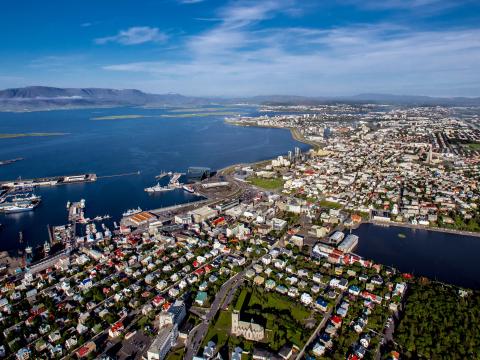
Reykjavík City, capital of Iceland, has put forward a climate policy paper with an action plan where goals are established for a carbon neutral city by 2040.
In Reykjavík all electricity is produced with hydroelectric power and houses are geothermally heated, energy usage in district heating releases no green house gas. The release of green house gasses in Reykjavík is minor compared with international figures, or 2,8 CO2 tons per person in the year 2013. Transport is the main source for green house gas emissions and is the largest challenge for the city.
In the city‘s Municipal Plan 2010-2030 the goal is to change travel modes so public transport will rise from 4% to 12% and the ratio of pedestrians and cyclists should rise from 19% to over 30% in 2030.
Reykjavík was the first municipality in Iceland to make a policy on reduction on green house gas emissions in 2009. In 2016 the Reykjavík City Council decided to go further and make even more ambitious goals: Reykjavík City will be carbon neutral by 2040.
„Cities play a key role in the fight against climate change. They can react quickly and have many possibilities of enacting change,“ says Dagur B. Eggertsson, Mayor of Reykjavík.
The Mayor adds that these reviewed goals for reducing green house gas emissions are in sync with what many of the world's most ambitious cities are aiming for but Reykjavík is in a prime position to follow them through because of its renewable energy sources.
Reykjavík began utilizing geothermal energy sources for central heating in 1930. In 1971 98% of homes were connected to geothermal water heating. Now all homes in the city and neighbouring municipalities are heated with geothermal energy.
The Mayor adds that these reviewed goals for reducing green house gas emissions are in sync with what many of the world's most ambitious cities are aiming for but Reykjavík is in a prime position to follow them through because of its renewable energy sources.
Reykjavík began utilizing geothermal energy sources for central heating in 1930. In 1971 98% of homes were connected to geothermal water heating. Now all homes in the city and neighbouring municipalities are heated with geothermal energy.
Reykjavík‘s goal is to increase the use of bicycles and buses as primary means of transport and to ensure that people have the chance of commuting to work on foot. With electric cars becoming more common Reykjavík will increase the availability of charging stations – preferably at home, in parking garages and on specific locations within the city. These goals are intrinsically linked to urban densification which also produces opportunities for a more efficient public transport system through the use of either light railways or a bus rapid transit system.